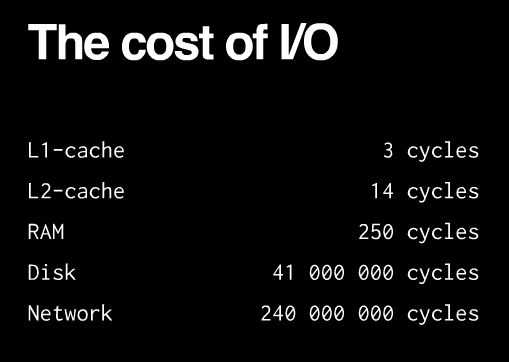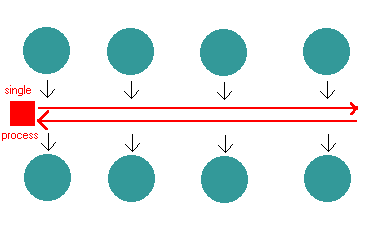Understanding the node.js event loop
来源:互联网 发布:小甲鱼python百度云 编辑:程序博客网 时间:2024/04/29 08:19
本文主要介绍nodeJS event loop,看看nodeJS是如何实现异步的,原文地址:http://blog.mixu.net/2011/02/01/understanding-the-node-js-event-loop/
The first basic thesis of node.js is that I/O is expensive:

So the largest waste with current programming technologies comes from waiting for I/O to complete. There are several ways in which one can deal with the performance impact (from Sam Rushing):
- synchronous: you handle one request at a time, each in turn. pros: simplecons: any one request can hold up all the other requests
- fork a new process: you start a new process to handle each request. pros: easy cons: does not scale well, hundreds of connections means hundreds of processes. fork() is the Unix programmer’s hammer. Because it’s available, every problem looks like a nail. It’s usually overkill
- threads: start a new thread to handle each request. pros: easy, and kinder to the kernel than using fork, since threads usually have much less overheadcons: your machine may not have threads, and threaded programming can get very complicated very fast, with worries about controlling access to shared resources.
The second basis thesis is that thread-per-connection is memory-expensive: [e.g. that graph everyone showns about Apache sucking up memory compared to Nginx]
Apache is multithreaded: it spawns a thread per request (or process, it depends on the conf). You can see how that overhead eats up memory as the number of concurrent connections increases and more threads are needed to serve multiple simulataneous clients. Nginx and Node.js are not multithreaded, because threads and processes carry a heavy memory cost. They are single-threaded, but event-based. This eliminates the overhead created by thousands of threads/processes by handling many connections in a single thread.
Node.js keeps a single thread for your code…
It really is a single thread running: you can’t do any parallel code execution; doing a “sleep” for example will block the server for one second:
// do nothing
}
So while that code is running, node.js will not respond to any other requests from clients, since it only has one thread for executing your code. Or if you would have some CPU -intensive code, say, for resizing images, that would still block all other requests.
…however, everything runs in parallel except your code
There is no way of making code run in parallel within a single request. However, all I/O is evented and asynchronous, so the following won’t block the server:
'SELECT SLEEP(20);',
function (err, results, fields) {
if (err) {
throw err;
}
res.writeHead(200, {'Content-Type': 'text/html'});
res.end('<html><head><title>Hello</title></head><body><h1>Return from async DB query</h1></body></html>');
c.end();
}
);
Why is this good? When do we go from sync to async/parallel execution?
Having synchronous execution is good, because it simplifies writing code (compared to threads, where concurrency issues have a tendency to result in WTFs).
In node.js, you aren’t supposed to worry about what happens in the backend: just use callbacks when you are doing I/O; and you are guaranteed that your code is never interrupted and that doing I/O will not block other requests without having to incur the costs of thread/process per request (e.g. memory overhead in Apache).
Having asynchronous I/O is good, because I/O is more expensive than most code and we should be doing something better than just waiting for I/O.

An event loop is “an entity that handles and processes external events and converts them into callback invocations”. So I/O calls are the points at which Node.js can switch from one request to another. At an I/O call, your code saves the callback and returns control to the node.js runtime environment. The callback will be called later when the data actually is available.
Of course, on the backend, there are threads and processes for DB access and process execution. However, these are not explicitly exposed to your code, so you can’t worry about them other than by knowing that I/O interactions e.g. with the database, or with other processes will be asynchronous from the perspective of each request since the results from those threads are returned via the event loop to your code. Compared to the Apache model, there are a lot less threads and thread overhead, since threads aren’t needed for each connection; just when you absolutely positively must have something else running in parallel and even then the management is handled by Node.js.
Other than I/O calls, Node.js expects that all requests return quickly; e.g. CPU-intensive work should be split off to another process with which you can interact as with events, or by using an abstraction like WebWorkers. This (obviously) means that you can’t parallelize your code without another thread in the background with which you interact via events. Basically, all objects which emit events (e.g. are instances of EventEmitter) support asynchronous evented interaction and you can interact with blocking code in this manner e.g. using files, sockets or child processes all of which are EventEmitters in Node.js. Multicore can be done using this approach; see also: node-http-proxy.
Internal implementation
Internally, node.js relies on libev to provide the event loop, which is supplemented by libeio which uses pooled threads to provide asynchronous I/O. To learn even more, have a look at the libev documentation.
So how do we do async in Node.js?
Tim Caswell describes the patterns in his excellent presentation:
- First-class functions. E.g. we pass around functions as data, shuffle them around and execute them when needed.
- Function composition. Also known as having anonymous functions or closures that are executed after something happens in the evented I/O.
- Callback counters. For evented callbacks, you cannot guarantee that I/O events are generated in any particular order. So if you need multiple queries to complete, usually you just keep count of any parallel I/O operations, and check that all the necessary operations have completed when you absolutely must wait for the result; e.g by counting the number of returned DB queries in the event callback and only going further when you have all the data. The queries will run in parallel provided that the I/O library supports this (e.g. via connection pooling).
- Event loops. As mentioned earlier, you can wrap blocking code into an evented abstraction e.g. by running a child process and returning data as it it is processed.
It really is that simple!
- Understanding the node.js event loop
- Understanding the node.js event loop
- Understanding the node.js event loop
- Understanding the node.js event loop
- Understanding the node.js event loop
- Understanding the Node.js Event Loop - Node.js at Scale
- node.js的event loop
- Node.js Event-loop事件循环
- node.js中Event loop机制
- Node.js Asynchronous - Callbacks - Event Loop - Single Thread - non-blocking
- node.js的轮循机制粗解(event loop)
- Js Event Loop
- Understanding node.js
- Understanding node.js
- The JavaScript Event Loop: Explained
- The JavaScript Event Loop: Explained
- glib-The Main Event Loop
- 探究如何整合 GLib Main Event Loop 和 Node.js 的 libuv
- Mac分区失败 (未能修改分区图,因为文件系统验证失败)
- 关于mmu,bootloader,dta以及各种乱七八糟
- Servlet学习一
- 动态控制ToolStrip上ToolStripButton的大小(包括图标的大小)
- 读取DXF格式文件的C++代码
- Understanding the node.js event loop
- sql server 2000 实现树形结构表格查询
- 何为分形
- effective C++(第三版)读书笔记一——条款二:尽量以const,enum,inline替换#define
- 设备管理
- Android系统组件 小练习
- Extreme6808策略路由
- 对内存的认识
- 基于Mapabc API的周边查询应用





